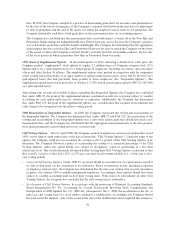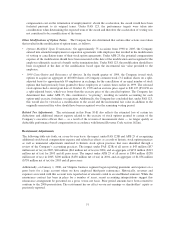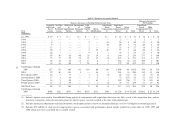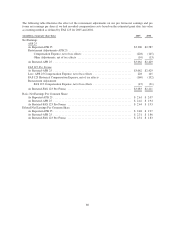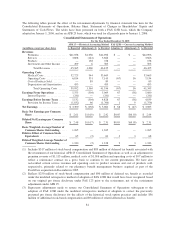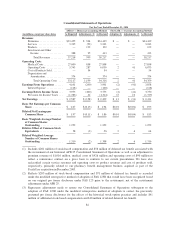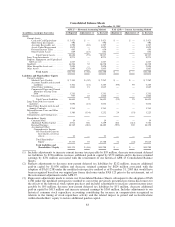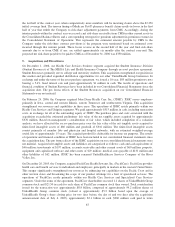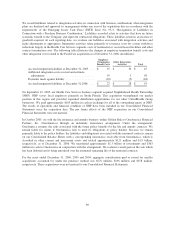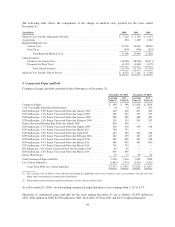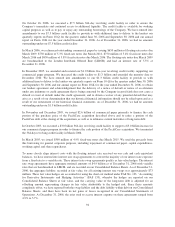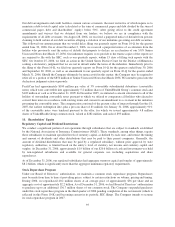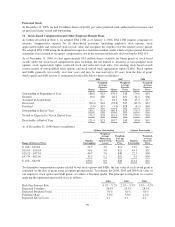United Healthcare 2006 Annual Report Download - page 88
Download and view the complete annual report
Please find page 88 of the 2006 United Healthcare annual report below. You can navigate through the pages in the report by either clicking on the pages listed below, or by using the keyword search tool below to find specific information within the annual report.4. Medicare Part D Pharmacy Benefits Contract
Beginning January 1, 2006, the Company began serving as a plan sponsor offering Medicare Part D prescription
drug insurance coverage under a contract with the Centers for Medicare & Medicaid Services (CMS). Under the
Medicare Part D program, there are six separate elements of payment received by the Company during the plan
year. These payment elements are as follows:
• CMS Premium — CMS pays a fixed monthly premium per member to the Company for the entire plan year.
• Member Premium — Additionally, certain members pay a fixed monthly premium to the Company for the
entire plan year.
• Low-Income Premium Subsidy — For qualifying low-income members, CMS pays some or all of the
member’s monthly premiums to the Company on the member’s behalf.
• Catastrophic Reinsurance Subsidy — CMS pays the Company a cost reimbursement estimate monthly to
fund the CMS obligation to pay approximately 80% of the costs incurred by individual members in excess
of the individual annual out-of-pocket maximum of $3,600. A settlement is made based on actual cost
experience subsequent to the end of the plan year.
• Low-Income Member Cost Sharing Subsidy — For qualifying low-income members, CMS pays on the
member’s behalf some or all of a member’s cost sharing amounts, such as deductibles and coinsurance. The
cost sharing subsidy is funded by CMS through monthly payments to the Company. The Company
administers and pays the subsidized portion of the claims on behalf of CMS, and a settlement payment is
made between CMS and the Company based on actual claims experience, subsequent to the end of the plan
year.
• CMS Risk-Share — If the ultimate per member per month benefit costs of any Medicare Part D regional
plan varies more than 2.5% above or below the level estimated in the original bid submitted by the
Company and approved by CMS, there is a risk-share settlement with CMS that is settled subsequent to the
end of the plan year. The risk-share adjustment, if any, is recorded as an adjustment to premium revenues
and other receivables or liabilities.
The CMS Premium, the Member Premium, and the Low-Income Premium Subsidy represent payments for the
Company’s insurance risk coverage under the Medicare Part D program and therefore are recorded as premium
revenues in the Consolidated Statements of Operations. Premium revenues are recognized ratably over the period
in which eligible individuals are entitled to receive prescription drug benefits. We record premium payments
received in advance of the applicable service period as unearned premiums.
The Catastrophic Reinsurance Subsidy and the Low-Income Member Cost Sharing Subsidy represent cost
reimbursements under the Medicare Part D program. The Company is fully reimbursed by CMS for costs
incurred for these contract elements and, accordingly, there is no insurance risk to the Company. Amounts
received for these subsidies are not reflected as premium revenues, but rather are accounted for as deposits, with
the related liability recorded in Other Policy Liabilities in the Consolidated Balance Sheets. Related cash flows
are presented as Customer Funds Administered within financing cash flows in the Consolidated Statements of
Cash Flows.
Pharmacy benefit costs and administrative costs under the contract are expensed as incurred and are recognized
in medical costs and operating costs, respectively, in the Consolidated Statements of Operations.
As a result of the Medicare Part D product benefit design, the Company incurs a disproportionate amount of
pharmacy benefit costs early in the contract year. For example, the Company is responsible for approximately
67% of a Medicare Part D beneficiary’s drug costs up to $2,250, while the beneficiary is responsible for 100% of
their drug costs from $2,250 up to $5,100 (at the Company’s discounted purchase price). Consequently, the
Company incurs a disproportionate amount of benefit costs in the first half of the contract year as compared with
86


